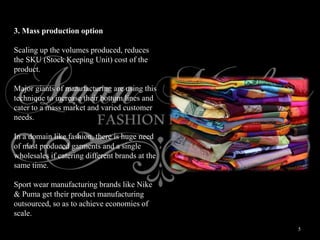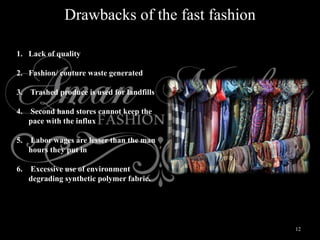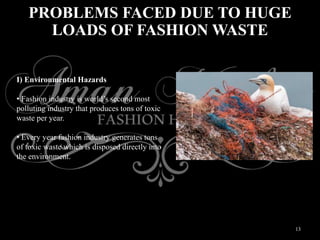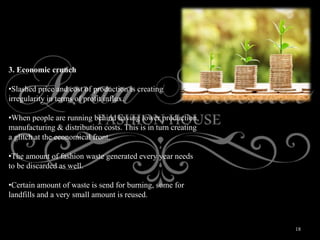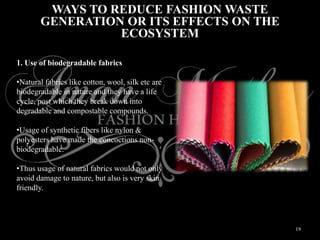Fashion waste | Aman Mathur
- 1. 1 FASHION WASTE Aman Mathur Fashion House
- 2. 2 “Buy less…Buy Better…Be happier” •Fashion waste is the amount of unused, factory rejected, discarded or stock cleared clothes & accessories discharged due to rapid pace of fashion industry. •Fashion industry always had a very short shelf life and the commodities always look up for renovation. •Due to which the fashion retails brands have made it a trend to change the complete stock within a very short duration of time. •Shoppers need to have always fresh stock in any store and with moderate pricing. Tendency of buying fresh clothes has increased tremendously within past 2 decades, along with major reduction in the cost of fabrics and finished dresses. •Easy availability of cheap clothing has increased the preview of fashion as a domain and has made it reach to every strata of the society. •Presently even tier 2 or 3 cities of India is having the fashion retail stores providing the national fashion to the end customers. SALE ! Flat 50% Off !! Bargain !! are certain terms that increases the heartbeat of any shopaholic and this has a special magnetic power that attracts the shoppers within the stores.
- 3. 3 REASONS FOR EASY & CHEAP AVAILABILITY OF CLOTHING 1. Synthetic fibers usage Long gone are the days when people used pure organic fibers for cloth manufacturing. Cotton, wool, cashmere, silk are some of the natural fibers which were used for making the dress fabric. Advent of synthetic fibers like rayon, polyester, acrylic, acetate & nylon has not only made the fabric blends versatile, but also has increased the durability of the fabric made. Blending natural fibers with artificial/ synthetic polymers has reduced the cost of the manufactured fabric.
- 4. 4 2. Globalised production & distribution facilities • With increased globalization and internationalization of brands and products, the fashion manufacturers have also shifted their base to different countries. • These shifting bases are dependent upon the easy & cheap availability of the raw materials in the local areas. • If we take the example of denim jeans manufacturing then there are a lot of raw materials requited, which are catered by different locations of the world. • The cotton is obtained from India, Spun from Pakistan, dying from China, cutting from Turkey and zipping from Japan. • Due to these factors the companies are able to obtain the cheapest rates utilizing the skills and raw material of the specific areas of the world.
- 5. 5 3. Mass production option Scaling up the volumes produced, reduces the SKU (Stock Keeping Unit) cost of the product. Major giants of manufacturing are using this technique to increase their bottom lines and cater to a mass market and varied customer needs. In a domain like fashion, there is huge need of mast produced garments and a single wholesales if catering different brands at the same time. Sport wear manufacturing brands like Nike & Puma get their product manufacturing outsourced, so as to achieve economies of scale.
- 6. 6 4. Cheap labor availability •Asian countries are filled with cheap labor, including people who are ready to spend longer man hours for a very reasonable wage. •Manpower can be obtained easily and economically from countries including Indian & Bangladesh. •For fashion industry production job, semi & unskilled labor is required in bulk amounts. •Due to which the production cost of the finished product goes even more down. •Due to these aforesaid reasons the fashion products availability of the mass market has increased to a greater extent. Since every coin has a flip side, so the flip side of this luxury is the amount of fashion waste generated every year due to a series of factors.
- 7. 7 QUANTUM OF FASHION WASTE GENERATED EVERY YEAR IN USA (As per US EPA) Recycled 16% Combusted 19% Landfills 65% Quantum of fashion waste generated (16 million tons)
- 8. 8 MAJOR FACTORS FOR FASHION WASTE GENERATION 1. Huge gap between the demand & supply •When it comes to apparel industry the amount of stock available and rotated at retail stores is much more than the demand of the customer •Every retail out tries to renovate the stock within a very short duration of time, which has increased the bulk of fashion waste generated. •If we analyze the stock availability at stores and the purchase frequency of the individual, there’s a huge gap between them.
- 9. 9 2. Reduced cost of fashion clothing •Major factors like bulk production, cheap availability of labor & cheap fabric availability has reduced the cost of manufacturing of clothing. •Imitations of big fashion brands are easily available on city streets with lower quality fabric & prints. •These low priced products increase the buying bulk of the customers which eventually ends up into the garbage bin, resulting into heaps of waste couture.
- 10. 10 3. Bulk production of fashion goods & globalised approach •Since every coin has its flip side, so has bulk production and globalization of manufacturing. •When we talk about the mass production of clothing, first effect is on the cost & price of the product. •And the flip side is on the mass produced goods which are either rejected for their defects, left unconsumed, picked by rat pickers etc. •This contributes majorly for the amount of fashion waste generated every year.
- 11. 11 4. Usage of synthetic fibers •Due to high maintenance nature of cotton, silk and other natural fibers, people started to blend polyesters into the natural fabrics •Usage of synthetic fibers though increase the life and durability of fabric but it hampers the stocks. •Storing huge amount of fabric is a task and it all ends up into bulk production. •Synthetic fibers are very harmful for individuals wearing it and for environment as well. •Thus the major contributor of the fashion waste remains fast fashion, or the rapidly changing stocks of the fashion retail outlets.
- 12. 12 Drawbacks of the fast fashion 1. Lack of quality 2. Fashion/ couture waste generated 3. Trashed produce is used for landfills 4. Second hand stores cannot keep the pace with the influx 5. Labor wages are lesser than the man hours they put in 6. Excessive use of environment degrading synthetic polymer fabric.
- 13. 13 PROBLEMS FACED DUE TO HUGE LOADS OF FASHION WASTE I) Environmental Hazards • Fashion industry is world’s second most polluting industry that produces tons of toxic waste per year. • Every year fashion industry generates tons of toxic waste which is disposed directly into the environment.
- 14. 14 a) Dying-Washing-Drying •Problem starts with the production procedure of the clothes, which includes dying, cleaning & drying. •Usage of synthetic harmful chemical dyes, puts not only environment, but also the people nearby into danger. These chemical dyes are harsh and damages the air, water and land with their manufacturing, usage & disposal. •Then second step involves washing off the dye, which requires gallons of sweet water. •Then drying, which consumes tones of fuels for drying the finished goods. •Government rules are strict enough for the safe discharge of effluents that comes out of the chemical factories or the factories using any chemicals. •But still very few manufacturers actually realize and work for safeguarding the environment.
- 15. 15 b) Microfibers pilferage •Usage of synthetic fabrics is increasing by every passing day, to reduce cost, maintenance & to increase the life and durability of the clothing. •The usage of synthetic fibers is hampering the environment in every way possible, including water& land. •When we wash our clothes the micro fibers get rubber off and goes into the drainage. •This in turn gets discharged into water bodies. Aquatic animals and fish are the primary consumers of these fibers. •Moving up the food chain, these aquatic animals are the major composition of costal area food structure. •So in turn these microfibers end up entering human bodies and being toxic in nature, damage the health to a greater extent.
- 16. 16 START
- 17. 17 2. Low wage labor •Fashion industry being extensively labor centric needs plenty of unskilled and semiskilled people to work day and night for it. •In order to reduce the cost of produce, the production needs to be scaled up using strong manpower and time. •Due to increasing competition, every manufacturer is trying to slash down the production cost which is making them employ lots of cheap labor. •This in turn is reducing the damage control features they can incorporate.
- 18. 18 3. Economic crunch •Slashed price and cost of production is creating irregularity in terms of profit influx. •When people are running behind having lower production, manufacturing & distribution costs. This is in turn creating a glitch at the economical front. •The amount of fashion waste generated every year needs to be discarded as well. •Certain amount of waste is send for burning, some for landfills and a very small amount is reused.
- 19. 19 WAYS TO REDUCE FASHION WASTE GENERATION OR ITS EFFECTS ON THE ECOSYSTEM 1. Use of biodegradable fabrics •Natural fabrics like cotton, wool, silk etc are biodegradable in nature and they have a life cycle, post which they break down into degradable and compostable compounds. •Usage of synthetic fibers like nylon & polyesters have made the concoctions non- biodegradable. •Thus usage of natural fabrics would not only avoid damage to nature, but also is very skin friendly.
- 20. 20 2. Usage of natural dyes •Artificial dyes are harsh toxic chemicals that do a multilevel damage. •Firstly at the time of initial dying process, secondly at the time of washing the dye and then when customers wears and washes the clothes. •Natural dyes use vegetable dyes like beetroots, blue berries, cherries, turmeric which neither damages neither the cloth nor the user.
- 21. 21 3. Recycling the clothes • Recycling is the ultimate and most important step towards achieving sustainability. •We have a tendency of discarding the clothes post very small number of usages. This can be nurtured by recycling the used clothes. •There are several designers who are recreating the used clothes into several other designs or designer wears.
- 22. 22 4. Choosing independent designers rather than retail outlets. •Retail chains cannot stay out of the bulk production and reduced pricing cage. They need to produce in bulk & within their costing limits to achieve the economies of scale and quantity. •Unlike retails, designer store or designer clothing are more exclusive and material & made can be easily tracked. •Independent designers are not in compulsion of producing in bulks since they work on exclusivity.
- 23. 23 5. Smart buying •Customer needs to be aware and conscious about the clothes or fashion accessories he/ she is buying. •This should be in habit to check the tag for getting the made and fabric content of the product. •A 100% cotton product would be far more sustainable and eco friendly than a polyester blend. •Buying cheap products to satisfy the shopping instinct would lead to buy un wanted and unused garments and products, which eventually ends up into garbage bins. •The most important factor that would influence and would act as a step towards having sustainability in fashion ecosystem, is to think before buying a clothing. •Demand to know about the content, fabric, place & year of make, this would not only make you realize the real value of product you are buying, but also would stop you to buy cheap trash products that wouldn’t last long.
- 24. 24 Buy less… Buy Better… Be happier…




